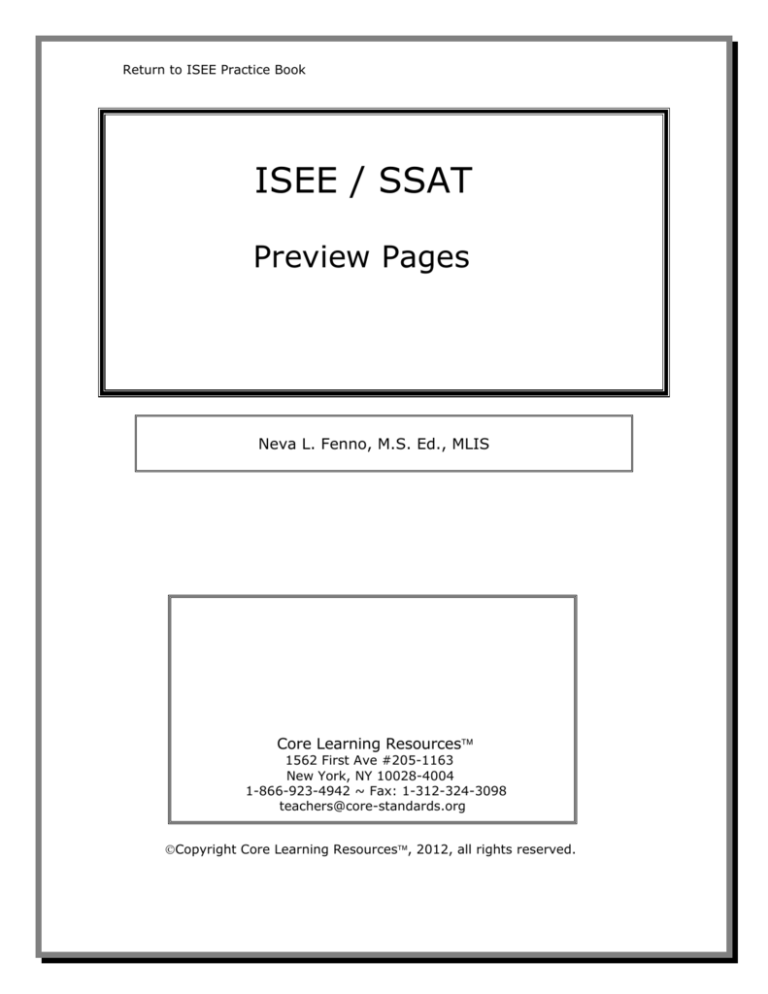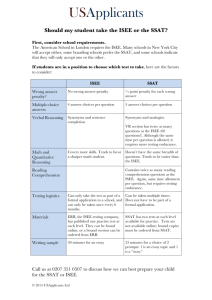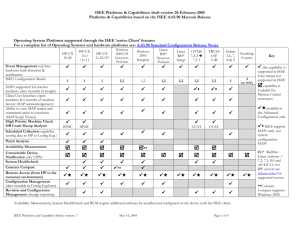
Return to ISEE Practice Book
ISEE / SSAT
Preview Pages
Neva L. Fenno, M.S. Ed., MLIS
Core Learning Resources
1562 First Ave #205-1163
New York, NY 10028-4004
1-866-923-4942 ~ Fax: 1-312-324-3098
teachers@core-standards.org
Copyright Core Learning Resources, 2012, all rights reserved.
Table of Contents
Introduction
a
Synonyms Pretest
1
Verbal Reasoning
6
Synonyms Post Test
10
Analogies
15
Quantitative Reasoning
35
Math Glossary
39
Reading Comprehension
74
Math Achievement Pretest
109
Math Achievement
119
Math Achievement Post test
124
The Essay (Writing Sample)
134
Index
139
Appendix A (Scoring)
a (141)
ISEE - Independent School Entrance Examination
The ISEE is an admission test that has three levels: A Lower Level,
Middle Level, and Upper Level. The Lower Level is for students
currently in grades 4 and 5 who are candidates for admission to grades 5
and 6. The Middle Level is for students in grades 6 and 7 who are
candidates for grades 7 and 8. The Upper Level is for students in grades
8 through 11 who are candidates for grades 9 through 12.
At all levels, the ISEE consists of three parts: (a) carefully constructed
and standardized verbal and quantitative reasoning tests that measure a
student's capability for learning; (b) reading comprehension and
mathematics achievement tests that provide specific information about
a student's strengths and weakness in those areas; and (c) an essay.
The ISEE essay is timed and written in response to a prompt. The essay
is not scored; it is photocopied and sent only to the targeted schools.
The ISEE testing levels, number of questions, and timing:
Lower Level
(candidates for Grades 5 and 6)
Total Time: 2 hours 20 minutes
Test
Verbal Reasoning
# of Items
34
Time (min)
20
Quantitative
Reasoning
Reading
Comprehension
Mathematics
Achievement
Essay
38
35
25
25
30
30
30
a
Middle Level
(candidates for Grades 7 and 8)
Test
Verbal Reasoning
# of Items
40
Time (min)
20
Quantitative Reasoning
37
35
Reading Comprehension
36
35
Mathematics Achievement
47
40
Essay
30
Total Time: 2 hours 40 minutes
Upper Level
(candidates for Grades 9–12)
Test
Verbal Reasoning
# of Items
40
Time (min)
20
Quantitative reasoning 37
35
Reading
Comprehension
36
35
Mathematics
Achievement
Essay
47
40
30
Total Time: 2 hours 40 minutes
b
The ISEE provides:
Standard assessment of each applicant’s skills and a ranking of
abilities and achievement against peers
Standards aligned with the National Council of Teachers of
English (NCTE), the International Reading Association (IRA), and
the National Council of Teachers of Mathematics (NCTM)
Confirmation from statisticians that each item is relevant,
content specific, and suited to providing the most accurate
assessments
Disclaimer: Core Learning Resources is not affiliated in any way to ERB or SSAT,
producers and publishers of the ISEE and SSAT tests. The material presented in this
guide is intended to assist a student who will prepare for these exams, but is not a
replica of either.
c
SSAT (Secondary School Admissions Test)
2012-2013 Standard Test Calendar
October 13, 2012
November 10, 2012
December 8, 2012
January 5, 2013
February 2, 2013
March 2, 2013
April 20, 2013
June 8, 2013
What is the SSAT?
The SSAT is a multiple choice test designed for students in grades 3
through 11 and is administered on three levels:
• Elementary (for students currently in grades 3-4)
• Middle (for students currently in grades 5-7)
• Upper (for students currently in grades 8-11)
Both the Middle and Upper level SSAT consist of verbal, quantitative
(math) and reading comprehension sections. The verbal questions
test your vocabulary, verbal reasoning, and ability to relate ideas
logically. The quantitative (math) questions test your ability to solve
problems involving arithmetic, basic algebra and geometry, and
concepts. The reading comprehension section tests your ability to
understand what you read. All tests are printed and administered in
English.
In addition to the sections listed above, the test includes a writing
sample portion. The style of the writing sample will differ depending
on which level test you take. Your essay is not graded, but a copy will
be sent to schools.
d
Reasons for Taking the SSAT
The SSAT measures student ability. It is not an achievement test;
therefore, it acts as a common denominator for schools in measuring
a student’s academic capabilities, regardless of school record. When
used for admission by independent schools, the test is only one piece
of information that is considered. Schools also review the applicant’s
school grades, volunteer or extracurricular participation, teacher
recommendations, essays and interview results. SSAT scores,
however, do carry some weight in varying degrees among
independent schools. Consequently, you should be as prepared to
take the test as possible.
The SSAT provides predicted 12th grade SAT scores for those
students taking the test in the 7th through 10th grades, participation
in this testing exercise will also provide you with valuable information
regarding your educational strengths and weaknesses.
SSAT "Standard Test"
A standard test is a group administration held at many sites
worldwide on 8 Saturdays each year.
You may take a standard test as often as you like, up to 8 times
per year. You may register online until the Wednesday prior to the
test date subject to availability.
For schedules and timelines:
SSAT Website: http://www.ssat.org
ISEE Website: http://erblearn.org/
e
Pretest - Synonyms - 20 minutes, 4 choices per item (ISEE
format)
1. inclination
A.
B.
C.
D.
category
contribution
design
tendency
anger
caricature
dissent
longing
3. adversity
A. cupidity
B. difficulty
C. diffidence
D. duplicity
4. mawkish
A.
B.
C.
D.
contumacious
copious
insipid
onerous
5. succinct
A.
B.
C.
D.
A.
B.
C.
D.
appraise
insinuate
justify
observe
7. capricious
2. furor
A.
B.
C.
D.
6. evaluate
burdensome
concise
palatial
superfluous
A.
B.
C.
D.
adolescent
importune
rambling
whimsical
8. ominous
A.
B.
C.
D.
anxious
arrogant
immature
portentous
9. credulous
A. austere
B. diaphanous
C. trustful
D. valid
10. invidious
A. capricious
B. envious
C. turgid
D. verbose
1
Verbal Test (Synonyms and Analogies)
Differences between SSAT and ISEE on this subtest:
SSAT gives you 5 choices (A-F), ISEE provides 4 (A-D)
We know a young man who reads the dictionary. He feels this is the only
way to learn vocabulary. As you grow older, you are exposed to more and
more words. Along the way you learn synonyms for words, or words that
mean the same thing. Hot and warm for instance are synonymous, not
exactly the same, but on a test, if warm was a choice for synonym of hot,
you would select it as your answer.
You just completed the pretest for this section, it is a very good sample
and shows the kinds of words you will face on the tests. It is modeled on
the ISEE with four choices. Explore the sites at the list below, then take the
posttest for the section.
There are so many wonderful websites that help with vocabulary learning,
here’s a list of some favorites:
http://www.vocabulary.co.il/ - games #1 Choice
http://www.vocabularycoach.com/ - 4,000 words for you to learn
http://www.sheppardsoftware.com/web_games_vocab.htm resources to explore
http://wordsmith.org/words/today.html - new word each day
http://www.ogtprep.com/highschool_ogt.htm - crosswords
http://www.synonym.com/ - synonyms and thesaurus
http://tinyurl.com/2wd3zgr - list of synonym sites
http://quizlet.com/create_set/ - make your own online flashcards fun with a friend
If we had our way, school schedules would include entire classes on
vocabulary development, it’s that important.
6
How to answer synonym questions
Read the question carefully. Consider every answer choice. One
choice is always the best response.
Eliminate and cross out obviously wrong choices, get them out of
your field of vision.
Use word analysis techniques to help you with difficult words.
Try using the word in a sentence of your own, you can write in the
book to try out your sentence. Think about different meanings of
some words. Perhaps you’ve focused on the wrong meaning.
Word Analysis Skills
How are words built? Certainly words are collections of letters in the
alphabet. You can actually increase your vocabulary and your test score by
learning about the structure of words. This will help you figure out the
meanings of unfamiliar words you come across in the verbal ability part of
the exam.
Knowing what the parts of words mean is the key to figuring out words
you’ve never seen before. Take a look at the word:
biography
7
You know that a biography is something written about a person’s life. But,
what words parts tell you this. The second part of the word “graphy” comes
from a Greek word that means “writing.”
The first part of the word “bio” is also from the Greek and means “life.” Put
the pieces together and you have “biography” the story of a person’s life. If
you add the Latin word for self “auto”, you get “autobiography”, a story
written about your own life. Think about other words that contain the same
parts; automobile, biochemistry, and autograph. Can you see how their
meanings are derived from their parts?
Studying root words is an exercise that will help you all your life. Another
tactic for developing a huge vocabulary is taking Latin in school. Many
independent schools still offer Latin as part of their curriculum. You might
consider making that one of the characteristics you value in your choice of
schools.
Each word part has a specific purpose. There are three types of word parts,
prefixes, roots or stems, and suffixes. Prefixes are attached to root words
at the beginning of the word, suffixes are attached at the end. Roots or
stems are the basic elements of words that determine their meaning.
Many root words cannot stand on their own. They need prefixes and/or
suffixes to become meaningful. Word roots can have both prefixes and
suffixes, and sometimes multiples of both. Each addition changes the
meaning of the word.
Learning about roots, prefixes and suffixes can be very boring if you’re
looking at lists and lists of them. Have some fun with it.
8
Posttest - Synonyms - 20 minutes 40 questions, 4 choices (ISEE format)
1. ferocity
A.
B.
C.
D.
gloominess
indigence
speed
truculence
concord
decline
effulgence
subjugation
3. volatile
A. agitated
B. changeable
C. conspicuous
D. erratic
4. estimate
A.
B.
C.
D.
conclusion
contradiction
equation
guess
5. exhaust
A.
B.
C.
D.
A.
A.
B.
C.
apposite
assiduous
genuine
questionable
7. dwindle
2. decay
A.
B.
C.
D.
6. veritable
annoy
deplete
engine
placate
A.
B.
C.
D.
diminish
eradicate
intertwine
verify
8. eccentric
A.
B.
C.
D.
distinctive
idiosyncratic
impromptu
recalcitrant
9. attractive
A. obstinate
B. prudent
C. slender
D. winsome
10. designate
A. calculate
B. conserve
C. name
D. sanction
10
A sentence that might work is “ice is an ingredient of a glacier”. See how
this carries through or not. If you’re thinking a path is an ingredient of a
forest, ask yourself “must a forest have a path”? Likewise in D, is a feather
an ingredient?
Circle your answer to each question. The first pages organize the analogies
according to specific types of relationships. This will help you recognize
those relationships and concentrate on them. The second part contains a
variety of analogy relationships in random order. This will give you practice
in determining what the relationship is before you attempt to complete the
analogy correctly.
Analogies based on synonym relationships. “:” stands for “is to” or “as”
1.SMALL : MINIATURE :
LARGE :
A. shark
B. dwarf
C. minute
D. giant
2. BOSS : EMPLOYER :
EMPLOYEE :
A. worker
B. president
C. manager
D. director
3. DIG : EXCAVATE :
A. attempt : prevent
B. avenge : revenge
C. try : convict
D. kill : slay
4. DEVIOUS : CIRCUITOUS :
A. yodel :
B. yield :
C. yield :
D. simmer
yield
wield
submit
: submit
5. PLEASURE : ENJOYMENT :
A. Satan : demon
B. hate : abhorrence
C. fate : love
D. hate : love
6. ORIGINATE : INVENT :
A. song : score
B. copy : imitate
C. study : work
D. copy : work
19
Quantitative Reasoning - Practice
1. In the simplest form, -11 - (-2) is
A. 7
B. 9
C.-9
D.-11
2. Find the average of 6.47, 5.89, 3.42, .65, and 7.09.
A. 3.920
B. 4.704
C. 4.705
D. 5.812
3. Change 0.03125 to a common fraction.
A. 3/64
B. 1/16
C. 1/64
D. 1/32
4. A roll of carpeting will cover 224 square feet of floor space. How many
rolls will be needed to carpet a room 36' X 8' and another 24' X 9'?
A. 2.25
B. 2.50
C. 4.25
D. 4.50
5. After deducting a discount of 30%, the price of a coat was $35.00. The
regular price of the coat was
A. $24.50
B. $42.00
C. $50.00
D. $116.67
35
SSAT/ISEE Mathematics Upper Level Quantitative Reasoning (Math
Part One (the other Math section is called Mathematics Achievement)
You cannot use a calculator on the SSAT or the ISEE
The #1 difficulty with this subtest is time, you have 35
minutes to answer 35 questions (ISEE). There are two differences
between the SSAT and ISEE on this quantitative reasoning sub-test.
The SSAT Upper Level test provides the student with 5 choices
for each multiple choice question, 4 on the Upper Level ISEE.
On the SSAT there are 30 questions, 35 minutes to finish, on the
ISEE, there are 35 questions in 35 minutes.
Questions on both quantitative reasoning subtests are multiple choice.
To help you manage your time, glance through all 35
questions, do the easiest ones first, then as you start doing the harder
ones, use process of elimination. Write in the book, and cross off
selections that are clearly incorrect. This helps to pare it down to size.
#1 Study Tip Reviewing your math vocabulary will greatly
improve your chances of success. There are some math glossary
games here;
http://www.ogtprep.com/mathgloss.htm
Words you should know on the next pages.
(If you have the Ebook version, click on the words for more
resources.)
40
One way to boost scores is to increase the rate at which you read,
there are some free Internet resources to help you do that.
Three steps of basic speed reading.
1. Avoid subvocalization - The worst reading habit of slow readers
is subvocalization -- the tendency to read the words to yourself
(move your lips) as you see them on the page.
2. Narrow in on the important parts - Read blocks of words instead
of individual ones, then pay attention to a paragraph's key
sentences early on, and skim or skip the rest if it's not essential.
3. Use a guide like your finger or a pen: Trace your guide along
each sentence as you read, making sure that the pace is
comfortable and effective in keeping your eyes where they
should be.
4. Use a pencil, underline words and sentences you think may
come up in the questions, take notes in the margins of the book.
Here are a couple of speed reading exercises you can do online:
http://www.spreeder.com/
http://www.mrkent.com/speedread/
Another quick tip – as you read, write a sentence in the margin of the
book that represents the main idea. Pay special attention to topic
sentences in each paragraph. This way, you won’t have to go back and
reread when the most common reading question is asked “what is the
main idea of this passage”. More online:
http://tinyurl.com/6nfyrn2
http://www.quia.com/pop/120023.html
77
Koala
Koalas, native to the Australian wilds, initially
proved difficult to keep alive in zoos. Because koalas
eat nothing but the leaves of the eucalyptus tree,
zoos provided them with an unlimited supply of
eucalyptus leaves. One zoo even planted eucalyptus
trees in a special grove to ensure that the koalas had
a continual supply of fresh leaves. However, koalas
kept in captivity always died within a year of their
arrival at the zoo.
Eventually it was discovered that eucalyptus
trees that are less than five years old sometimes
generate hydrocyanic acid in their leaves. Taking in
small quantities of this acid is fatal to the koala. In
their natural habitat, the koalas’ senses tell them
which eucalyptus trees have dangerous leaves, and
they simply move on to other trees until they find
leaves that are safe to eat. But in captivity, when
their keepers unknowingly were giving them leaves
contaminated with acid, the koalas were left with only
two options: eat the poisonous leaves or starve.
Either option was fatal to the trapped koalas.
Fortunately, today’s zoos use special tests to
distinguish between poisonous eucalyptus leaves and
safe ones, and now koalas are eating well and
thriving in zoos.
1. What is the purpose of this article?
A. to inform
B. to persuade
C. to entertain
D. to express opinion
E. to express regret
78
2. What does the word contaminated mean in the following
phrase?
But in captivity, when their keepers
unknowingly were giving them leaves
contaminated with acid, the koalas
were left with only two options: eat the
poisonous leaves or starve. Either
option was fatal to the trapped koalas.
A. carried with
B. polished with
C. poisoned with
D. grown from
E. put in a box
3. What tone does the author establish in the article?
A. critical
B. hopeful
C. straightforward
D. humorous
E. complimentary
(1)
(A) This article was written to inform. Author’s
purpose is the reason or reasons an author has for
writing a selection. If students learn while they are
reading, one of the author’s purposes may have been to
inform. In this article students learn many things about
the koala. If readers enjoyed what they read, one of the
author’s purposes may have been to entertain. If readers
changed the way they thought about a topic or issue, one
of the author’s purposes may have been to persuade. In
a persuasive article however, you would see an explicit
reference to point of view and many supporting details to
bolster the point of view.
(2)
(C) The first way to figure out the meaning of a word
is from its context. The context is the other words and
sentences that are around the new word. Use the hints
and clues of the other words and sentences. In this case,
you have the word “poisonous” and “fatal” to help.
79
Math Skills Pretest - 35 Questions, 35 Minutes, Multiple Choice
7. Identify the graph that shows the
location of the point on the coordinate
grid.
2, 4
b g
A.
5
4
3
2
1
1 2 3 4 5 6
8. Find the mean, median, mode(s), and
range of the data.
16, 22, 14, 12, 20, 19, 14, 11
A. mean: 16
median: 16
mode: 14
range: 11
B. mean: 16
median: 15
mode: 14
range: 11
C. mean: 16
median: 16
mode: 14
range: 5
D. mean: 16
median: 14
mode:15
range: 11
8.
B.
5
4
3
2
1
9. Which shows the number below written
as a decimal?
sixty-six and eighty-seven thousandths
1 2 3 4 5 6
C.
5
4
3
2
1
A. 66.87
B. 0.6687
C. 6,687,000
D. 66.087
9.
10. Complete the statement with <, >, or =.
7.81 ? 7.18
1 2 3 4 5 6
A. <
B. >
C. =
D.
10.
5
4
3
2
1
11. Divide. Round to the nearest tenth, if
necessary.
6.08 ÷ 0.008
1 2 3 4 5 6
A. 76
7.
B. 0.7
C. 760
D. 7.6
11.
112
Math Skills Pretest - 35 Questions, 35 Minutes, Multiple Choice
12. Find the GCF.
70, 90
A. 10
B. 126
C. 630
D. 2
12.
13. Write the decimal as a fraction or mixed
number in simplest form.
0.065
65
10,000
A.
13
2
B.
C.
13
200
D. 15
5
13
16. Find the amount.
7
Cost of pound of steak at $16 per
8
pound.
A. $56
B. $10
C. $3.50
D. $14
16.
17. Find the quotient.
2
12 ÷
3
A.
13.
1
6
B. 6
C. 18
D.
1
18
17.
14. Estimate the sum or difference.
1
2
18 – 4
3
5
A. 19
B. 20
C. 14
18. Thirty gallons best describes the amount
of ? .
D. 13
14.
A. water that a bathtub will hold
B. milk in a full jug
C. sugar in a pitcher of homemade
lemonade
15. Find the elapsed time.
7:49 P.M. to 6:46 A.M.
D. water a car washing bucket will hold
A. 14 h 35 min
B. 10 h 57 min
C. 9 h 3 min
D. 14 h 57 min
18.
15.
113







